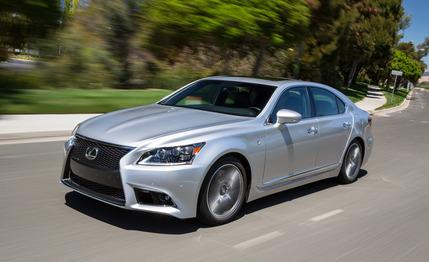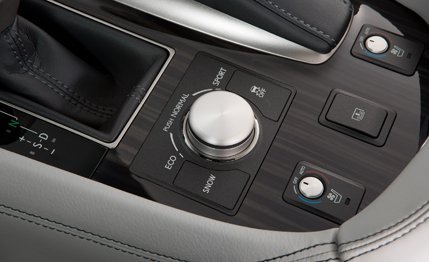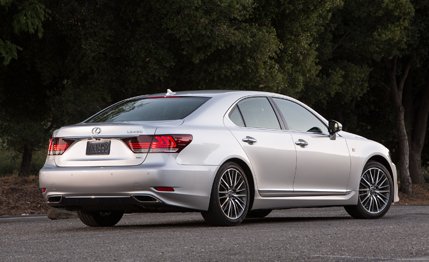
 First Drive Review
First Drive Review
Let’s say the LS nomenclature actually stands for something: L for “luxury” and S for “serene.” It’s a fitting summation of Lexus’s flagship sedan, which isn’t entirely new for 2013 but rather substantially made over. Lexus says fully half of the LS’s 6000 bits and pieces are new. But even though it's not a wholesale revamp, the update successfully modernizes the car's styling, creature comforts, and character.
Like the previous version, the 2013 LS conforms to the Lexus philosophy of inconspicuous consumption. The sedan’s imposing yet unadorned exterior is largely the same as before but for one significant change: The subtle, trapezoidal grille has been replaced by the corporate zigzaggy “spindle” maw that looks as if it were ready to eat people, animals, and casseroles. Combined with the reworked rear end, the new look takes the LS from applesauce to something near aggressive.
There are seven flavors of the LS, variously formed from among two wheelbases, rear- or all-wheel drive, a new F Sport model, and a hybrid model. Across most of the line, internal combustion is performed by a slightly more powerful, 4.6-liter V-8 that cranks out 386 hp (360 in AWD models) and is backed by an eight-speed automatic transmission. The top-of-the-line car, the LS600hL hybrid, uses a longer-stroke version of the V-8 that expands displacement to 5.0 liters and boosts output to 389 hp; that car drives through a continuously variable transmission. The total system output is 438 hp.


There are two suspension systems, one sprung by coils and one by air, each of which is directed by myriad sensors and processors. The same computational processes adjust the steering effort and engine and throttle responses according to driver settings. In the base LS460, the system can be set to eco, normal, and sport modes; air-suspension models add sport-plus and comfort modes.
We spent most of our time in the all-wheel-drive version of the F Sport—it’s also available with rear-drive—and found the differences among the modes to be fairly subtle, like the difference between Bud and Bud Light. The most noticeable nuance is in steering feel. In sport-plus mode, the power assist is reduced, and the sense of control and fluidity is increased. We flogged the car over insanely convoluted roads in the mountains around California’s Silicon Valley and found it to be surprisingly maneuverable for its size and mass. The F Sport gets special treatments inside and out, including a mesh grille, front fascia with brake-cooling ducts, and diffuser-look piece at the rear; the wheels are forged and 19 inches in diameter. The ride height is lower by 0.4 inch. The cabin has brushed aluminum in place of the other cars' wood trim, and the pedals are finished in the metal stuff, too. The F Sport also features a sound generator that increases engine noise in the cabin under hard acceleration. What it doesn't offer is an increase in power; the package mostly improves driving feel and provides better body control.
Lexus itself doesn’t tout the LS in any form as a quintessential sports sedan, and it’s not as focused as is the latest GS; the LS doesn't need to be. It is a nearly ultimate boulevardier, its sophisticated technology and innovative hardware concealed from the driver by a façade of impeccable quality and subtle design. The Audi A8 and the Jaguar XJ are more precise and more rewarding to take to their limits, although a comparison test ought to tease out exactly where this latest Lexus stands.
The attention to finish and detail in the interior of the LS borders on the obsessive. The new, optional Shimamoku interior finish is an example: Shimamoku, which translates as “striped wood,” involves the layering of dark and light veneers in a process that Lexus says requires 67 steps over 38 days. All the materials are of the highest quality, and craftsmanship is top-notch, and any place the driver touches is padded or polished. Space is abundant front and rear—the Executive package that includes a rear-seat ottoman is again available—and the seats are as comfortable as any you’ll find in this class. Amenities abound, including a 12.3-inch-wide flat screen that displays everything from GPS info to smartphone data. It’s all accessed via Lexus’s love-it-or-hate-it joystick control nub/mouse located on the center console.


Beyond the luxurious rear-seat-focused Executive pack, options include a suite of nanny tech such as blind-spot monitoring, dynamic cruise control, a collision-avoidance system, and driver-attention monitoring. Active high-beams, quad-zone climate control, and a 19-speaker stereo also are available.
From the brand’s inception, Lexus has captured a profitable portion of one-percenters who shun ostentation and appreciate quality, a mission spearheaded by the LS. Judging by its long list of luxury features and the lineup’s overall serene character, this latest flagship will maintain the status quo.